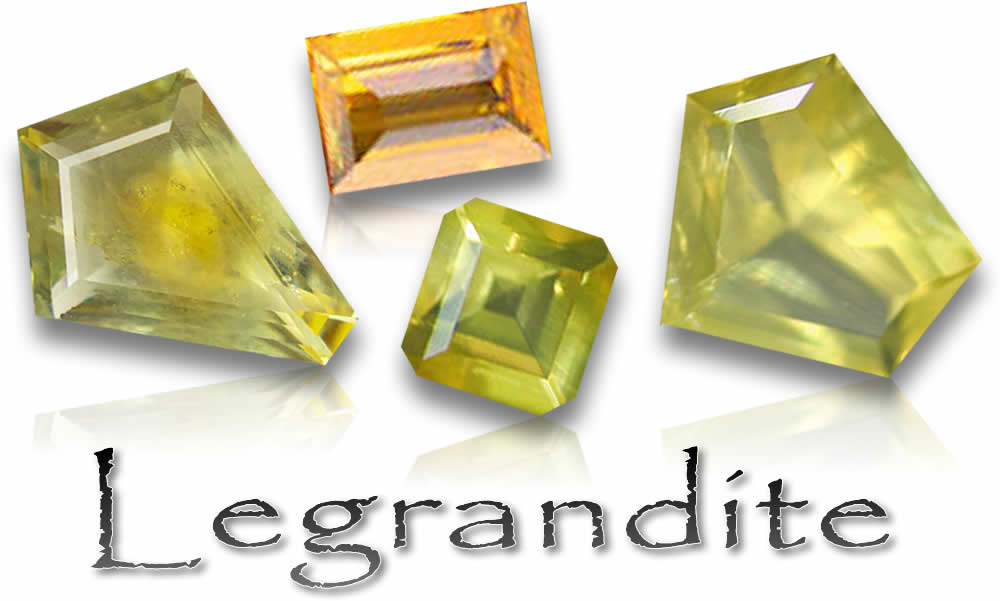What can I find in this article?
Legrandite Information - Learn all about this nusual gemstone

Legrandite Gemstones, A Toxic Collecters Gem
Legrandite gemstones are an exquisite and rare variety of minerals with hidden danger. They belong to the mineral group of arsenates and are typically composed of zinc arsenate, which imparts them with their characteristic color and crystal structure.
They are too soft for jewelry but their fiery, vibrant colors and crystal formations have excited collectors for gemstone collectors since the discovery of the mineral. Usually, they’re displayed as specimens in their natural state away in cases or museums.
Legrandite is a rare and vibrant mineral that's prized for its striking color and crystal formation. It is often found in Mexico, and valued in collectors' circles.
The most common hue of legrandite is a bright, lemon-yellow shade, reminiscent of a sunlit garden. However, variations in color can occur, ranging from pale yellow to deep golden tones. The gemstones are known for their exceptional transparency, allowing light to penetrate and illuminate their internal beauty - reminiscent of the radiance of a roaring fire.
Named after the French mineralogist Leonidas Legrand, these gemstones have gained popularity among mineral specimen collectors and gem-cutting aficionados for their distinct appearance and limited availability.
In this article let’s see how legrandite has become a mineral that’s highly sought-after in the gemstone market while exploring its characteristics, origins, and significance.
Origin and Occurrence of Legrandite
Legrandite gemstones are only found in a few locations worldwide. Historically, one of the most renowned sources of legrandite was the Ojuela Mine in Mapimí, Durango, Mexico. This mine is known for producing exceptional legrandite specimens with stunning crystal formations. In fact, Mexico is the only known source of legrandite rough that's facetable.
Legrandite gemstones are only found in a few locations worldwide. Historically, one of the most renowned sources of legrandite was the Ojuela Mine in Mapimí, Durango, Mexico. This mine is known for producing exceptional legrandite specimens with stunning crystal formations. In fact, Mexico is the only known source of legrandite rough that's facetable.
Legrandite’s Significance, Typical Sizes, and Rarity
Legrandite gemstones hold great significance for collectors and gemstone enthusiasts. Their rarity and aesthetic appeal make them highly coveted. The brilliant yellow color is their main draw, and the formations of legrandite crystal clusters are truly remarkable. These reasons and their rarity has launched their popularity in the collector's markets.
Faceted legrandite stones typically range in size from 2 to 4 carats, although there have been reports of a 10-carat stone. However, finding larger cut stones is extremely rare, and even 1-carat gems are difficult to come by because of the limited quantities of quality rough.
Due to their scarcity, and toxicity, legrandite gemstones are primarily sought after by collectors, museums, and gemstone connoisseurs. Their exquisite beauty and unique crystal formations make them prized specimens for display.
Is Legrandite a Hazardous Substance?
The short answer is yes. Legrandite contains toxic arsenic in its mineral form, making ingestion the most dangerous way of exposure. Wearing legrandite as jewelry can lead to scratches on the stone, potentially producing loose particles that may be accidentally ingested. Thus, we advise against using legrandite gems for jewelry purposes.
When working with legrandites, gem cutters should exercise special precautions to ensure their safety.
While displaying legrandite specimens does not typically pose any risks, it is crucial to secure them out of the reach of small children and pets.
Caring for Legrandite Gemstones
As with any gemstone, care is essential to preserve the beauty and longevity of legrandite. They should be protected from harsh chemicals, extreme temperatures, and prolonged exposure to sunlight, as these can cause fading or damage to the stone.
Cleaning legrandite gemstones with a soft cloth or brush, and mild soap or a specialized gemstone cleaner is recommended to maintain their luster and shine.
Legrandite Properties
|
Category: |
Arsenate group |
|
Color: |
Colorless to yellow |
|
4.5 |
|
|
1.675 - 1.740 |
|
|
Luster: |
Vitreous |
|
3.98 - 4.04 |
|
|
Transparency: |
Transparent to translucent |

